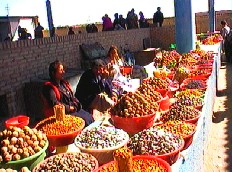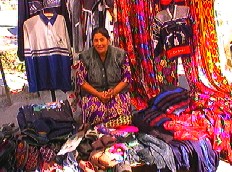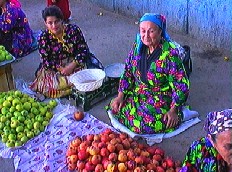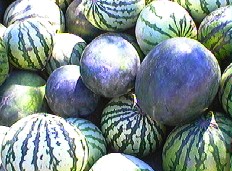 Dried fruit and nuts
Dried fruit and nuts Clothes
Clothes Fruit stalls
Fruit stalls Melons
MelonsA market in this country assumes the appearance of a fair or festival. The Central Asiatic visits it often from a distance of ten or twenty miles, purchasing perhaps a few needles or other trifles; but his real object is the love of display, for on such occasions he mounts his finest horse and carries his best weapon.
After the quiet and sanitised pedestrian streets of Khiva's Ichan Kala, a visit to the bustling bazaar is a welcome change and a reassurance that the spirit of the Silk Road is still as active as ever. The bazaar is open from morning until early afternoon seven days a week, although Sunday is still market day and Thursdays also tend to be busier than usual. The best time to experience the bazaar is early on a Sunday morning when stalls sprout up on empty streets and the whole shopping area mushrooms in size. Here Khivans are at their best - buying and selling and greeting friends and acquaintances. Donkey carts crammed full of villagers and vegetables make their way past old men selling melons and brightly clothed women setting up their stalls. In winter Khivan men can be seen at their most stately, boasting impressive Turkoman sheepskin coats and Astrakhan hats while carefully sorting through mountains of melons in search of the sweetest. At the same time, old women, barely visible under swathes of woollen scarves, haggle over pomegranates, lemons and carrots.Arminius Vambery "Travels in Central Asia" 1864
But the bazaar is not merely a place for observation and photography - there are plenty bargains to be had! The cheapest place to buy bottled mineral water, shashlik (kebab) and samsas (meat pastries) is just at the entrance to the Tim. Don't miss the fruit and vegetable sections which are crammed full of amazingly fresh and juicy produce during the summer months. Also of interest are the brightly coloured "beshiks" (cots used for swaddled babies) and the dazzling chests given to brides on their wedding day. Behind the bread stalls look out for the money changers who are always ready to offer tourists their services. Next to them are various clothing and material stalls with prolific selections of brightly coloured and textured materials as well as a fine array of hand-knitted and silk scarves. Keep your eyes open too for river pearls, traditional khalats (jackets), local confectionery plus dried fruit and nuts.
Further to the left lies the carpet bazaar which is often popular with tourists. Whilst factory-made carpets hold pride of place, the handwoven kilims known as "palas" are what most tourists go looking for. These bright, multi-coloured, woollen rugs are extremely cheap and provide none of the difficulties of their antique counterparts at the airport.
Bargaining is something alien to many cultures and can often be perceived by some tourists as an ordeal. However it can be great fun, a definite Silk Road experience and a good way of making friends. To really get ahead at bargaining in Khiva, print out the Phrase Book section in the Guidebook. This lists useful words and sentences in the Khorezm dialect - guaranteed to be an instant hit with incredulous looking stall-keepers! Another good tip is to have a look around and ask prices in several places. You may find that they vary more than you'd expect. In general, whilst prices are definitely upped for foreigners, Khiva is not like parts of the Middle East where tourists expect to be quoted at least double the price before bargaining commences. Here stall owners may be insulted if you aim for half their slightly overpriced first offer! Some vendors can be pushy, but never feel pressurised to buy something that you don't want.











